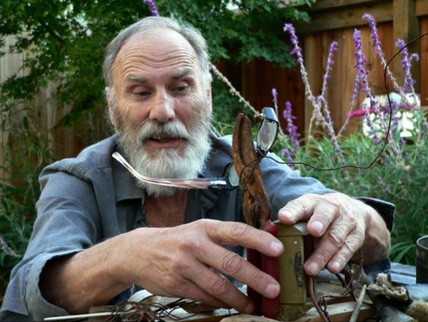
- Source: ARTFORUM
- Author: As told to Andy Campbell
- Date: September 30, 2014
- Format: DIGITAL
George Herms discusses his archives and exhibition in Austin, Texas
IN THE BEGINNING WAS THE STORYBOARD—
LOVE is not just the word with which George Herms signs his work but an expression of a particular ethos. Well known in Beat generation poetry, art, and 1960s-era California Assemblage circles, he was also involved with Wallace Berman’s influential publication Semina. Herms speaks here about a series of recent collage works exhibited in “LOVE George Herms” at testsite in Austin, Texas, which are on view from September 7 to October 19, 2014, as well as the recent acquisition of his archives by the Getty Research Center.

George Herms in Irvine, California, 2011. Photo: Sue Henger.
IN THE BEGINNING WAS THE STORYBOARD—isn’t that how the Bible starts out? A collaboration with a fictitious artist who integrates film, video, installation, sculpture, drawing, original music, and performance. That’s what I do, but now that text becomes a found paragraph for discussing artists of our time. Artists don’t want to be boxed in, or at least I never wanted to be.
Within the work, I’m the boss; I know what’s happening. My technique is to look at magazines upside down, and if I find something I enjoy, I tear it out. I’m a tear-rrorist. Like panning for gold with scissors, I cut out whatever is interesting to me. Then those pieces begin to dance around and form collages. Generally, I work on a coffee table, so that’s my natural scale. Besides the rusty-dusty stuff, I have an interest in color, which comes from working with bright and vibrant printer’s inks via my independent LOVE Press.
Some of the collages in my current show at testsite are composed of pieces of my archives returned to me by the Getty. And so this is an autobiographical body of work. For example, there’s a document in one of these collages, a piece of paper where you can see a list of names on the reverse side. This is from when I was executing the facsimile edition of Semina, and those are the people that are in the first issue—Cameron’s there, and so is Walter Hopps.
For fifty years I never threw anything away, so there was five decades of junk mail, documenting every election and all that stuff. I was like a scientist recording what was going on that day. But once I got to the Getty Research Institute, things changed. I found out about archival categories, and they would put my things into different boxes: for example, letters and correspondence. If the letter had the date on it, the Getty didn’t also need the envelope to establish date. So they threw away all the envelopes; they were winnowing. We had a sign on the office wall, which I made, which read WINNOW, DON’T WALLOW. In that little office, there was a table and a camera aimed straight down on the documents. There was also a second camera pointed at me with a microphone on it and I went over every single piece of paper accumulated over those years. All told, it was about twenty boxes’ worth of envelopes and newspapers thrown away, and naturally I asked, “Can I keep them?”
After fifty years, I’m going through my own wastebasket and finding there’s more. It gets ridiculous, because the challenge is to make gold out of dross. The less interesting the thing is, the bigger the challenge.

